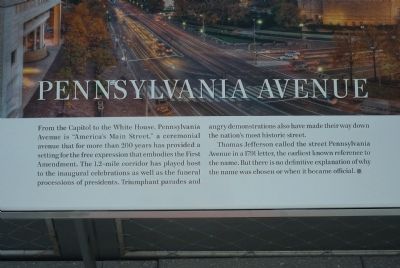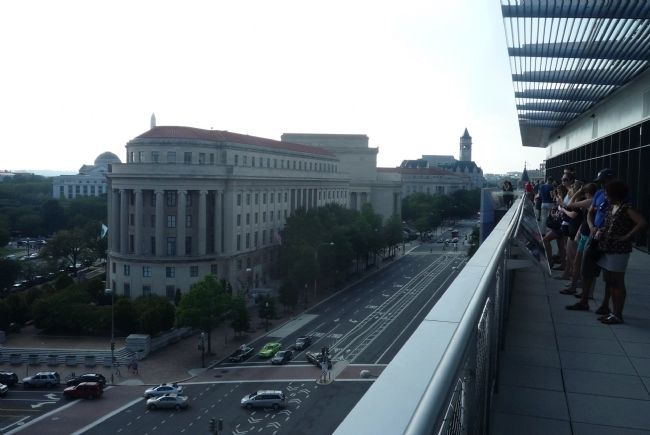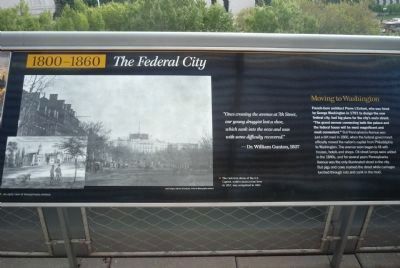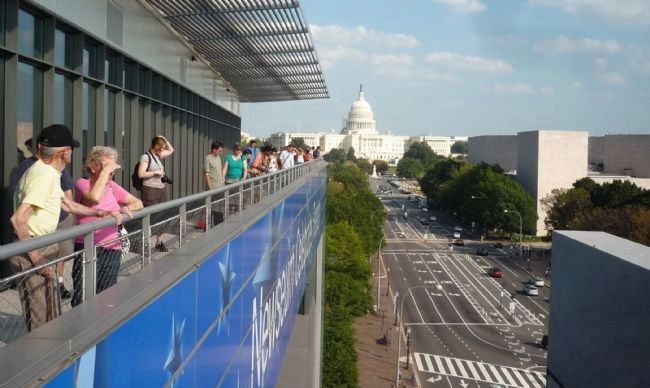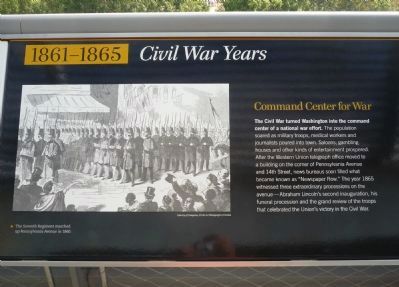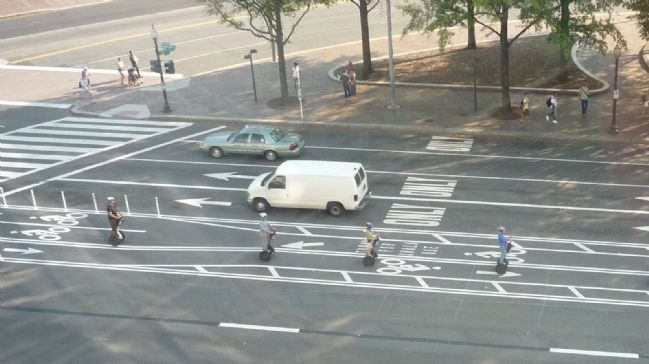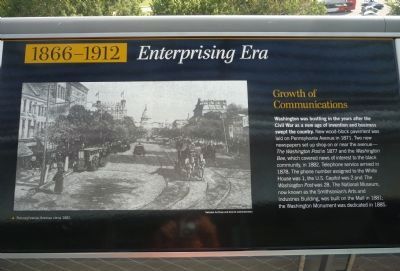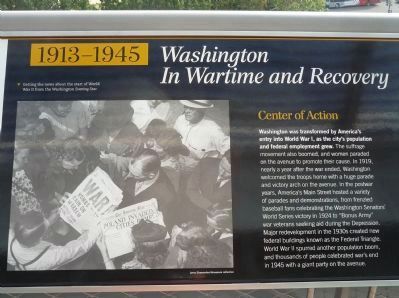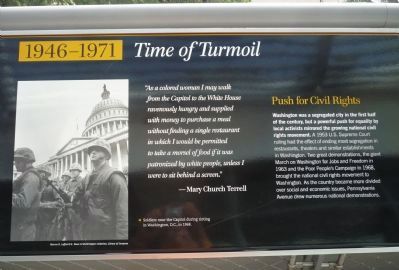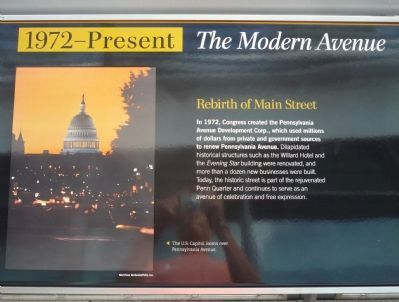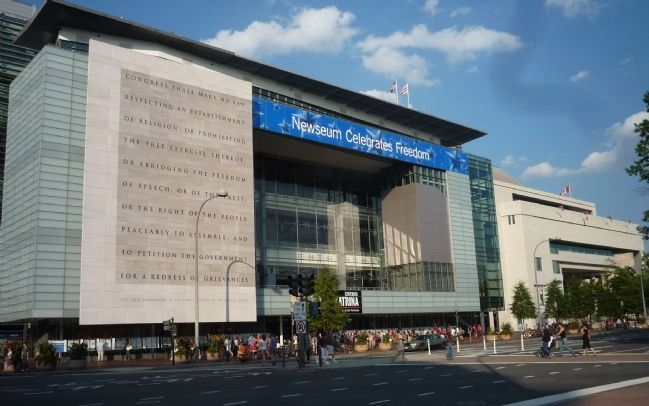Judiciary Square in Northwest Washington in Washington, District of Columbia — The American Northeast (Mid-Atlantic)
Pennsylvania Avenue
— [The Newseum Terrace] —
[Panel 1]
From the Capitol to the White House, Pennsylvania is “America’s Main Street,” a ceremonial avenue that for more than 200 years has provided a setting for the free expression that embodies the First Amendment. The 1.2-mile corridor has played host to the inaugural celebrations as well as the funeral processions of presidents. Triumphant parades and angry demonstrations also have made their way down the nation’s most historic street.
Thomas Jefferson called the street Pennsylvania Avenue in a 1791 letter, the earliest known reference to the name. But there is no definitive explanation of why the name was chosen or when it became official.
[Panel 2]
1800-1860 - The Federal City - Moving to Washington.
"Once crossing the avenue at 7th Street, our young druggist lost a shoe, which sank into the ooze and was with some difficulty recovered." - Dr. William Gunton, 1807.
French-born architect Pierre L'Enfant, who was hired by George Washington in 1791 to design the new federal cit, had big plans for the city's main street: "The grand avenue connecting both the palace and the federal house will be most magnificent and most convenient." But Pennsylvania Avenue was just a dirt road in 1800, when the federal government officially moved the nation's capital from Philadelphia to Washington. The avenue soon began to fill with houses, hotels and shops. Oil street lamps were added in the the 1840s, and for several years Pennsylvania Avenue was the only illuminated street in the city. But pigs and cows roamed the street while carriages lurched through ruts and sank in the mud.
[Panel 3]
1861-1865 - Civil War Years - Command Center for War.
The Civil War turned Washington into the command center of a national war effort. The population soared as military troops, medical workers and journalists poured into town. Saloons, gambling houses and other kinds of entertainment prospered. After the Western Union telegraph office moved to a building on the corner of Pennsylvania Avenue and 14th Street, news bureaus soon filled what became known as "Newspaper Row." The year 1865 witnessed three extraordinary processions on the avenue - Abraham Lincoln's second inauguration, his funeral procession and the grand review of the troops that celebrated the Union's victory in the Civil War.
[Panel 4]
1866-1912 - Enterprising Era - Growth of Communications.
Washington was bustling in the years after the Civil War as a new age of invention and business swept the country. New wood-block pavement was laid on Pennsylvania Avenue in 1871. Two new newspapers set up shop on or near the avenue--The Washington Post in 1877
and The Washington Bee, which covered news of interest to the Black community, in 1882. Telephone service arrived in 1878. The telephone number assigned to the White House was 1, the U.S. Capitol was 2, and The Washington Post was 28. The National Museum, now known as the Smithsonian's Arts and Industries Building, was built on the Mall in 1881; the Washington Monument was dedicated in 1885.
[Panel 5]
1913-1945 - Washington in Wartime and Recovery - Center of Action.
Washington was transformed by America's entry into World War I, as the city's population and federal employment grew. The suffrage movement also bloomed, and women paraded on the avenue to promote their cause. In 1919, a year after the war ended, Washington welcomed the troops home with a huge parade and victory arch on the avenue. In the postwar years, America's Main Street hosted a variety of parades and demonstrations, from frenzied baseball fans celebrating the Washington Senators' World Series victory in 1924 to "Bonus Army" veterans seeking aid during the Depression. Major redevelopment in the 1930s created new federal buildings known as the Federal Triangle. World War II spurred another population boom, and thousands of people celebrated war's end in 1945 with a giant party on the avenue.
[Panel 6]
1946-1971 - Time of Turmoil - Push for Civil Rights.
"As a colored woman I may walk from the Capitol to the White House ravenously hungry and supplied with money to purchase a meal without finding a single restaurant in which I would be permitted to take a morsel of food if it was patronized by white people, unless I were to sit behind a screen."
Mary Church Terrell.
Washington was a segregated city in the first half of the century, but a powerful push for equality by local activists mirrored the growing national civil rights movement. A 1953 U.S. Supreme Court ruling had the effect of most segregation in restaurants, theaters and similar establishments in Washington. Two great demonstrations, the giant March on Washington for Jobs and Freedom in 1963 and the Poor People's Campaign in 1968, brought the national civil rights movement to Washington. As the country became more divided over social and economic issues, Pennsylvania Avenue drew numerous national demonstrations.
[Panel 7]
1972 to Present - The Modern Avenue - Rebirth of Main Street.
In 1972, Congress created the Pennsylvania Avenue Development Corp., which used millions of dollars from private and government sources to renew Pennsylvania Avenue. Dilapidated historical structures such as the Willard Hotel and the Evening Star building were renovated and more than a dozen new businesses were built. Today the historic street is
part of the rejuvenated Penn Quarter and continues to serve as an avenue of celebration and free expression
Erected by the Newseum.
Topics and series. This historical marker is listed in these topic lists: African Americans • Government & Politics • Notable Places. In addition, it is included in the Mary Church Terrell series list. A significant historical year for this entry is 1791.
Location. 38° 53.564′ N, 77° 1.151′ W. Marker is in Northwest Washington in Washington, District of Columbia. It is in Judiciary Square. Marker is on Pennsylvania Avenue Northwest (Alternate U.S. 1) east of 6th Street Northwest (U.S. 50), on the right when traveling west. Touch for map. Marker is at or near this postal address: 555 Pennsylvania Avenue Northwest, Washington DC 20001, United States of America. Touch for directions.
Other nearby markers. At least 8 other markers are within walking distance of this marker. Andrew W. Mellon (within shouting distance of this marker); Embassy of Canada, Washington, DC (about 300 feet away, measured in a direct line); Protecting Consumers and Competition (about 300 feet away); 601 Pennsylvania Avenue (about 400 feet away); Chief Justice John Marshall (about 400 feet away); Washington City Spring (about 500 feet away); John Marshall (about 600 feet away); Ending Slavery in Washington (about 600 feet away). Touch for a list and map of all markers in Northwest Washington.
